Issue Archive
Table of Contents
EDITORIAL
Introduction to a review series on pathophysiology and treatment of acute GVHD
Edited by Associate Editor Robert Zeiser, this Review Series presents the current understanding of the pathophysiology of and therapeutic approaches to acute graft-versus-host disease (aGVHD). The articles discuss the role of the microbiome in contributing to aGVHD and review how novel cellular therapies, biologicals, and small-molecule inhibitors may advance its treatment.
BLOOD COMMENTARIES
PLENARY PAPER
CDK6 is an essential direct target of NUP98 fusion proteins in acute myeloid leukemia
In a Plenary Paper, the authors describe their investigation of targets of nucleoporin 98 (NUP98) fusion oncogenes, the products of recurrent translocations found in poor-prognosis acute myeloid leukemia (AML). Using mouse models and transcriptomic analysis, they found multiple transcriptional targets of NUP98 fusions and identified CDK6 as a potential candidate for targeted therapy for this subset of AML.
REVIEW SERIES
Pathophysiology and Treatment of Acute GVHD
Microbiome-intestine cross talk during acute graft-versus-host disease
Edited by Associate Editor Robert Zeiser, this Review Series presents the current understanding of the pathophysiology of and therapeutic approaches to acute graft-versus-host disease (aGVHD). The articles discuss the role of the microbiome in contributing to aGVHD and review how novel cellular therapies, biologicals, and small-molecule inhibitors may advance its treatment.
Cellular therapies for graft-versus-host disease: a tale of tissue repair and tolerance
Edited by Associate Editor Robert Zeiser, this Review Series presents the current understanding of the pathophysiology of and therapeutic approaches to acute graft-versus-host disease (aGVHD). The articles discuss the role of the microbiome in contributing to aGVHD and review how novel cellular therapies, biologicals, and small-molecule inhibitors may advance its treatment.
Cytokines and costimulation in acute graft-versus-host disease
Edited by Associate Editor Robert Zeiser, this Review Series presents the current understanding of the pathophysiology of and therapeutic approaches to acute graft-versus-host disease (aGVHD). The articles discuss the role of the microbiome in contributing to aGVHD and review how novel cellular therapies, biologicals, and small-molecule inhibitors may advance its treatment.
Immunopathology and biology-based treatment of steroid-refractory graft-versus-host disease
Clinical Trials & Observations
Edited by Associate Editor Robert Zeiser, this Review Series presents the current understanding of the pathophysiology of and therapeutic approaches to acute graft-versus-host disease (aGVHD). The articles discuss the role of the microbiome in contributing to aGVHD and review how novel cellular therapies, biologicals, and small-molecule inhibitors may advance its treatment.
HEMATOPOIESIS AND STEM CELLS
Epidermal growth factor receptor–dependent DNA repair promotes murine and human hematopoietic regeneration
Radiation and chemotherapy damage hematopoietic stem and progenitor cells. Chute et al demonstrated that epidermal growth factor receptor promotes stem cell regeneration through activation of DNA repair pathways in both mouse and human stem cells.
IMMUNOBIOLOGY AND IMMUNOTHERAPY
A minority of T cells recognizing tumor-associated antigens presented in self-HLA can provoke antitumor reactivity
Tumor-associated antigens (TAAs) targeted by immunotherapy are predominantly self-antigens that are overexpressed or aberrantly expressed in malignancy. Roex et al examined the T-cell repertoire in normal donors and report that naturally occurring T cells directed against TAAs are almost entirely of low reactivity, requiring priming to become active against their target antigens.
LYMPHOID NEOPLASIA
YWHAE/14-3-3ε expression impacts the protein load, contributing to proteasome inhibitor sensitivity in multiple myeloma
The high protein load in multiple myeloma cells renders them sensitive to proteasome inhibitors. The authors demonstrate that the chaperone protein 14-3-3ε regulates protein synthesis in myeloma cells and its expression correlates with sensitivity to proteasome inhibition.
RED CELLS, IRON, AND ERYTHROPOIESIS
Cold agglutinin disease revisited: a multinational, observational study of 232 patients
The authors present a large retrospective analysis of 232 patients with cold agglutinin disease. They demonstrate higher prevalence of symptomatic disease in colder climates and confirm a high rate of durable responses with rituximab or rituximab-bendamustine therapy.
THROMBOSIS AND HEMOSTASIS
COVID-19 and coagulation: bleeding and thrombotic manifestations of SARS-CoV-2 infection
Clinical Trials & Observations
The authors present a retrospective analysis of bleeding and thrombosis in 400 patients hospitalized with COVID-19. They report venous thromboembolism and bleeding rates of 9.5% and 4.8%, respectively, and confirm the predictive value of elevated D-dimer levels for thrombosis, bleeding, and death.
TRANSPLANTATION
The gut microbial metabolite trimethylamine N-oxide aggravates GVHD by inducing M1 macrophage polarization in mice
The gut microbiome has become established as a contributor to graft-versus-host disease (GVHD). Using a mouse model, the authors demonstrated that choline-metabolized trimethylamine N-oxide (TMAO) produced in the gut worsens GVHD through activation of the NLRP3 inflammasome and modulation of macrophage polarization. A high-choline diet or TMAO enhances GVHD, which is reversed by inhibition of the NLRP3 inflammasome.
LETTER TO BLOOD
BLOOD WORK
-
Cover Image
Cover Image
![issue cover]()
Gut microbial metabolite trimethylamine N-oxide–enhanced allogeneic T-cell infiltration into the bone marrow of a graft-versus-host disease mouse. The image shows the merged immunofluorescence of donor-derived tdTomato+ (red) and CD3+ (green) T cells in the host femur. The nuclei were stained with 4′,6-diamidino-2-phenylindole (DAPI, blue). See the article by Wu et al on page 501.
- PDF Icon Front MatterFront Matter
- PDF Icon Table of ContentsTable of Contents
- PDF Icon Editorial BoardEditorial Board
Advertisement intended for health care professionals
Email alerts
Advertisement intended for health care professionals


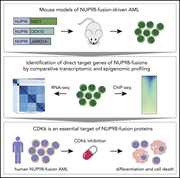
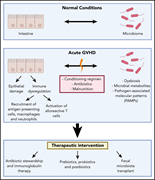

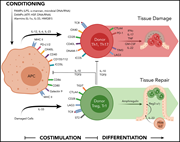

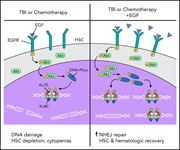

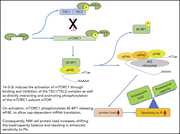

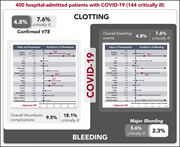
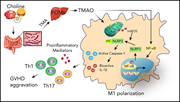

A common protein target for an uncommon subtype of AML